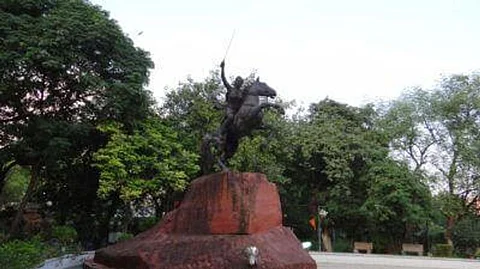
- Home
- न्यूजग्राम
- NewsGram USA
- India
- World
- Politics
- Entertainment
- Culture
- Lifestyle
- Economy
- Sports
- Sp. Coverage
- Misc.
- NewsGram Exclusive
- Jobs / Internships

Over the years, several battles took place, led by heroes- irrespective of their gender, has changed the shape of India's history. One such hero was Jhansi of Rani, who was brave and ferocious in every sense of the term. Born to a Maratha family in Varanasi, Rani Laxmi Bai was one of the most leading personalities of the first war of India's independence, which started in 1857. This year, 2017 marked her 159th death anniversary on June 18. Very few women marked their name in History of India's struggle of independence and Rani of Jhansi, was one of them.
Rani Laxmi Bai (Source: Wikimedia Commons)
Rani Laxmi Bai enjoyed more freedom than any other women of that era as her father used to work in the Peshwa Court of Bithoor. She not only practiced self defense, archery, horse riding, but also formed an army of women in the court. Rani Lakshmi Bai was born in 1828, in Varanasi as 'Manikarnika', however, her date of birth remains disputed.
Rani Laxmi Bai got married to Gangadhar Rao, King of Jhansi, when she was just 7 years old. Her marriage was short-lived and therefore, at the age of 18, she became Rani of Jhansi. Soon after, the Britishers took advantage of her lack of experience and seized Jhansi from her. They asked her to leave the fort as the ruler and offered her Rs. 60,000 as pension. But Laxmi Bai was so determined to defend Jhansi that she denied them and form an army of their own. The army not only included men but also women.
Army of Rani Laxmi Bai. Image Source: Wikimedia Commons
Rani not only defended Jhansi from Britishers but also from neighboring states. In September to October 1857, she fought with King of Orchha and Datia.
British appointed Sir Hugh Rose to capture Jhansi. In 1858, Britishers tried to enter Jhansi. They looted common people and killed many people, including Women and children. Hence, Laxmi Bai decided to fight against Britishers along with the army. The war continued for about two weeks. Women were not only equipped with arms but were also supplying food to the people in need. But when Britishers attacked Jhansi on March 31, they were able to enter Jhansi.
Fort of Jhansi in 1857. Image Source: Wikimedia Commons
After Britishers were able to capture Jhansi, Laxmi Bai tied her adopted son Damodar Rao on her back and start fighting with two swords, left Jhansi to ask Peshwas to support her against the Britishers. Peshwa decided to help her by sending his army. When Kalpi was attacked by Britishers, Laxmi Bai came in front and fought. Her attack set-back the British Army.
Follow NewsGram on Facebook: NewsGram
On June 18, Britishers captured Gwalior from all four sides. Rani decided to fight the enemies instead of surrendering herself to the Britishers. She started fighting, but fell down from her horse during the war and started bleeding. As she dressed like an army man, nobody was able to recognise her. Then her faithful servants took her to nearby Gangadas Mutt and gave her 'Gangajal'.
Her last wish was that she should not be touched by any Britisher and hence was burnt by a hermit and she died at an early age of 29.
-This report was compiled by a staff-writer at NewsGram.
ALSO READ:
